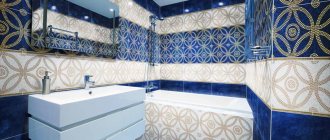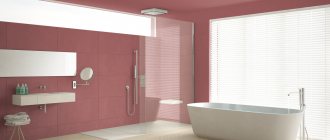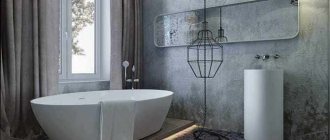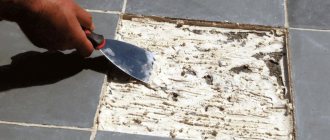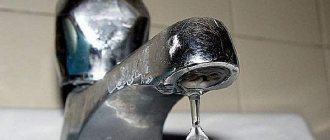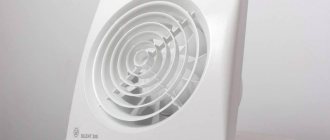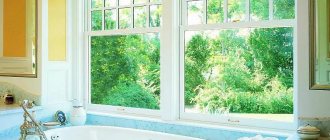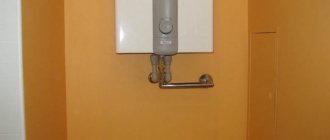Arranging a bathroom in a house made of aerated concrete is a responsible task. It is necessary to ensure comfort for users, and at the same time protect the material from contact with water and steam.
A bathroom is an essential element of any home, ensuring hygiene and cleanliness for the owner and his family. The specific purpose and presence of water in the form of liquid and steam put forward special requirements for the design and finishing of the bathroom. In a house made of aerated concrete, these requirements become more stringent - if under normal conditions it is necessary to ensure the strength of the connection between the base and the finish, then aerated concrete needs reliable and hermetically sealed off from contact with moisture in any form. This is not an easy task, since finishing of aerated concrete is carried out according to its own rules.
Building materials for bathroom walls
As you know, any room begins, in the dry language of construction terms, with the construction of enclosing structures.
In order to make the right choice of building materials for walls in the bathroom, it is necessary to take into account many sometimes incompatible factors, the characteristics of each material and make the most of their positive qualities, leveling out the shortcomings if possible. Let's look at what types different types of structures have, be it a concrete or brick wall in the bathroom. The construction of bathroom walls faces numerous technical and legislative restrictions. Incorrect selection of material for building walls can lead not only to legal consequences for the owners of the premises, but also to physical destruction of existing buildings. Compliance with the requirements of regulatory documentation and construction technology guarantees both high quality construction and its safe operation.
Installation of a foundation for a country toilet
Since foam blocks are a fairly light material, the construction of the foundation will be simplified. I lay it out with used bricks in two rows. To do this, I protect the base from the excavated soil and pour out a mixture of coarse sand and cement.
I compact the base and begin laying bricks on concrete mortar. I lay a double layer of roofing felt on top of the foundation as insulation.
Properties of building materials used in the construction of bathroom walls
Construction of walls in the bathroom
Of all the variety of properties, building materials for bathrooms must meet a fairly small list of characteristics that make it possible to obtain a balanced building structure without significant labor costs and waste of materials:
- Specific gravity. One of the key parameters that directly shows how much a building structure that occupies a certain volume will weigh. Since the walls of the bathroom are erected on interfloor slabs, exceeding the permissible load, which is 800 kg/m2 for new floors, can cause the collapse of the structure;
- Load bearing capacity. Directly depends on the strength of the material and its ability to withstand static and dynamic loads without destruction;
- Fire resistance. Ability to withstand exposure to open flame and high temperature for a specified period of time. Has a direct impact on the safety of the premises. Failure to comply with fire resistance requirements may serve as grounds for refusal to accept the premises by the interdepartmental commission;
- Moisture resistance. The ability of a material to resist the effects of water vapor and withstand direct contact with water without causing irreversible changes in structure and strength. Plays a big role in creating and maintaining the microclimate of the bathroom, the resistance of walls to the spread of fungal microorganisms;
- Thermal conductivity. The property of materials to prevent the transfer of heat outside the bathroom. Without taking into account the thermal conductivity of the material, it is impossible to create the desired microclimate;
- Linear thermal expansion. One of the main parameters that you need to pay attention to when using plastic products. All plastics, when temperature fluctuates, significantly change their linear dimensions, which can lead to surface deformation.
Construction of a block or brick toilet
Preparing the cesspool and foundation
First of all, let's look at how to build a permanent toilet from blocks and bricks. The work should begin with the construction of a cesspool, which in our case will serve as the foundation. Instructions for doing this work look something like this:
First of all, you need to mark the site. It is advisable to position the pit so that it is at least 30-40 centimeters longer than the cabin. In this case, you can make a hatch behind the toilet to pump out waste. During the marking process, it should be taken into account that the minimum width between the walls should be one and a half meters. Those. the width of the pit must be determined taking into account the thickness of the walls;
- Next you need to dig a hole to a depth of about one and a half meters;
- then the bottom is covered with sand and crushed stone, after which it is carefully compacted. If there is groundwater nearby, the bottom should be reinforced and covered with concrete;
Analysis of materials for bathroom walls
Ceramic brick
Use of ceramic bricks
Until recently, brickwork was the only way to lay the walls of a bathroom and toilet inside a living space. Availability of material, low complexity of work and high strength of structures. A bathroom with a brick wall has excellent performance, is easy to install indoors and can have a complex geometric shape. The brickwork of the bathroom walls is made of clay solid or hollow bricks.
Depending on the size of the room, you can use half-brick or one-quarter brick masonry, but the second option requires a more highly qualified mason and a one-third increase in time spent on building the wall. A brick wall made of facing hollow bricks can serve as a decorative element of the interior without additional finishing.
Important! When using bricks, it must be remembered that the masonry is carried out according to a scheme called ligation of seams, when the load of the upper row is distributed over two underlying bricks, this ensures high strength of the masonry. If a bathtub with a brick wall is to be plastered, then the masonry is done in a waste area for better adhesion of the plaster mortar.
Ceramic bricks, intended for laying walls and partitions, have the following advantages:
- High compressive strength, determined by the brand of brick, where the number shows how much load in kilograms 1 square cm of surface can withstand;
- Good surface wear resistance;
- Low water absorption at 14% for ordinary bricks and no more than 3% for clinker bricks;
- Good sound insulation properties that meet the requirements of regulatory documentation;
- Environmentally friendly material made from natural clay without chemical additives.
Some inherent disadvantages of ceramic ordinary brick reduce the attractiveness of the material for building walls indoors:
- High dead weight. A square meter of masonry weighs about 220 kg;
- High cost of high-quality brickwork;
Foam concrete
Foam concrete for creating walls in the bathroom
A modern building material created on the basis of cement-sand mortar with the addition of foaming additives, which determine the porous structure of the material after hardening. The properties of foam concrete are ideally suited for the construction of non-load-bearing partitions inside finished building structures.
The walls in the bathroom made of foam blocks are small in thickness and have their own weight. One standard size block weighing no more than 18 kg replaces about 20 ceramic bricks with a total weight of about 80 kg. A more than 4-fold reduction in the load on the floors allows you to build plumbing cabins anywhere in the room.
The material is very environmentally friendly and does not contain harmful impurities. Foam blocks for the bathroom do not absorb moisture, creating a favorable indoor microclimate. The foam block made from natural ingredients does not burn, and its heat and sound insulating properties make it possible to reduce the thickness of the wall being built to a size sufficient to maintain the strength characteristics of the structure.
Note: The material can be easily cut and drilled with tools designed for wood, and does not require a thick layer of plaster for final finishing.
Foam blocks are made by casting in special molds or cutting from a finished monolith, which does not affect the quality of the material. Foam blocks for bathroom partitions have the following advantages:
- Low dead weight, guaranteeing the impossibility of overloading the floors;
- Low shrinkage under load;
- High sound and heat insulation properties;
- Easy installation and processing, with the ability to cut out shaped structures;
- Low price;
- Low water absorption. The foam block can float in water for a long time without compromising the properties of the material;
With all the positive qualities, foam blocks also have some disadvantages that must be taken into account during construction:
- Difficulty in securing heavy objects;
- Long-term gain of structural strength and some shrinkage of the material;
- The need to apply a plaster layer;
- The use of a synthetic foaming agent instead of a natural one reduces the strength of the block.
Aerated concrete
Aerated concrete for bathroom walls
One of the varieties of cellular concrete, which is used as a material for bathroom walls, is aerated concrete. The cement-based material is chemically foamed using aluminum powder and hardens at high temperatures in a special autoclave. Hardening of aerated concrete blocks occurs in special installations at high temperatures, which increases the technical characteristics of the material. After cooling, aerated concrete continues to increase its strength over time to the value established by the characteristics.
Aerated concrete blocks in the bathroom must be insulated from moisture from the inside, since the porous structure can absorb large amounts of moisture over a long time. Aerated concrete has the highest strength characteristics among cellular concrete, and its surface holds finishing materials better. Bathroom walls made of aerated concrete are almost as strong as brick walls, but are several times lighter, and laying the blocks using a thin layer of special glue reduces the cost of work.
Important! One of the varieties of aerated concrete is gas silicate, produced using a similar technology from a silicate mixture and a foaming agent. It is undesirable to use gas silicate blocks in the bathroom due to their high absorbency and low thermal resistance.
With standard block sizes of 600x200x100mm, they have the following advantages:
- High mechanical strength;
- Better heat and sound insulation than foam concrete;
- Excellent fire resistance. The material can be on fire for several hours;
- Ease of machining without the use of special tools;
- Less amount of cement used in production;
The increased porosity of the material entails some easily removable disadvantages:
- increased hygroscopicity;
- the highest cost among cellular concrete.
cinder block
Cinder block for the construction of partitions
When choosing a material for the walls in the bathroom, you can successfully use a universal hollow building stone obtained by vibrocompression of cement mortar filled with granulated metallurgical slag. Cinder block is cheap to manufacture and can even be produced independently without the use of expensive equipment. Bathroom blocks are made hollow with a total thickness of 100 mm, which improves technical and operational characteristics and reduces material consumption.
The main advantages of cinder block:
- High mechanical strength;
- Resistance to water and high temperature;
- Relatively light weight;
- Low cost and the possibility of self-production;
- Possibility of using any filler capable of being held together with cement binders.
Among the disadvantages it is necessary to note:
- Increased surface roughness, requiring plastering work;
- Application for processing special cutting tools.
Important! When choosing cinder blocks, you need to pay attention to the components from which they are made. Not all are suitable for use in residential premises, because... may contain hazardous impurities and components for human health. Such blocks can only be used for the construction of households. buildings
Sheet materials based on cement binders
Cement boards
Construction materials for the bathroom based on cement binders include a group of sheet materials in which various fillers are used. This is a cement-bonded particle board, in which waste from woodworking and flat asbestos-cement sheets of various thicknesses, better known as “slate,” are used as filler.
The materials are sufficiently durable and can be mounted on a wooden or metal frame using standard fasteners. It is advisable to use slate walls in the bathroom as a base for finishing materials when sealing technological channels in order to avoid an unreasonable reduction in the internal space. The advantages of slate as a material for building walls lie in its excellent water resistance, and all other qualities can be attributed rather to disadvantages:
- Increased fragility;
- Use of asbestos as a filler, which releases harmful substances when heated;
- Quite heavy weight;
Cement particle board is much better suited for the construction of walls in terms of its performance qualities:
- High strength in the longitudinal direction:
- Good sound insulation properties;
- Increased water resistance and resistance to rotting;
- Ability to resist high temperatures and prevent the spread of fire;
- Excellent vapor permeability.
Among the disadvantages of DSP, one can note the increased weight and some complexity of installation compared to plasterboard.
Tongue-and-groove gypsum board
Gypsum board with grooves
You can significantly speed up the installation of a plumbing cabin if you use tongue-and-groove blocks for the bathroom and toilet. But faster doesn't mean better. Tongue-and-groove slabs are high-tech gypsum products cast in a metal mold and equipped with special locks to facilitate joining the slabs to each other. The rather large dimensions of the slab, 500x667mm, allow the construction of smooth gypsum walls with perfectly fitted joints, which do not require further pre-treatment.
A regular tongue-and-groove slab in a bathroom allows you to immediately glue the facing tiles or paint them with preliminary finishing putty. The thickness of the slab is 80 mm and is considered sufficient to ensure the strength of the enclosing structures of the plumbing cabin and provide the required level of thermal insulation.
For your information: Hollow PGP, in which air channels are provided to lighten the weight, has an insufficient level of sound insulation. Acoustic vibrations arising in the channels can be amplified to such an extent that the tongue-and-groove wall in the bathroom will serve as a kind of acoustic system, relaying sounds occurring behind adjacent walls.
The use of gypsum, even with water-repellent additives, does not allow the PGP to be considered completely waterproof, which requires additional waterproofing. Despite all the attractiveness of the tongue-and-groove slab, only a few advantages can be identified when constructing walls in the bathroom:
- High speed of installation with prepared floor surface;
- Low cost of material and the opportunity to save on subsequent finishing operations.
But this material has many more disadvantages:
- Low strength, especially for hollow slabs, when fastening heavy equipment causes serious problems;
- Insufficient moisture resistance;
- Poor sound insulation;
- Heavy weight, which makes it difficult to install the upper part of the wall;
- A large amount of harmful gypsum dust when cutting the material.
If the technology is strictly followed and the adhesive materials specified in the instructions are used, you can use GGP for the construction of bathroom walls, but it is better to make tongue-and-groove partitions in bathrooms that separate part of the room for the toilet.
Sheet gypsum materials
Drywall sheets for bathroom
Only the very lazy have not written about the use of plasterboard systems, but the correct use of technology and a precisely calculated power structure allow one to obtain excellent results, especially when it is necessary to build combined walls in the bathroom during reconstruction, when some part of the old wall cannot be dismantled and it is necessary to join the existing one and new design.
Using gypsum fiber sheets instead of traditional gypsum plasterboard, the strength of which is twice that of plasterboard. Bathroom walls made of gypsum fiber board can withstand significant loads and provide sufficient levels of heat and sound insulation. As practice shows, the widespread use of gypsum sheet systems is due to quite large advantages:
- Dry construction technology, which can be performed by a limited number of workers;
- Good heat and sound insulation properties;
- Obtaining a flat surface ready for final finishing;
- Possibility of saving money by doing the installation yourself;
- Possibility of hidden placement of communications;
- Light weight structure.
Plaster walls in the bathroom also have some disadvantages:
- the need for protection from direct prolonged contact with water;
- Difficulty in securing heavy objects.
Concrete walls in the bathroom
Construction of concrete walls
Until recently, in the construction of panel houses, ready-made concrete sanitary cabins were used, which had only two advantages - ease of installation and a fairly large load-bearing capacity.
Thin concrete walls in the bathroom do not have sufficient heat and sound insulation, but have the ability to increase vibrations. To improve the performance properties, it is necessary to either carry out additional measures, which can lead to a significant reduction in the internal space of an already small bathroom or the need to dismantle the existing cabin and erect walls from modern materials.
Plastic
Plastic walls in the bathroom can be used if it is necessary to create mobile or temporarily used objects. The lack of vapor permeability of most types of plastics and strong flammability with the release of toxic substances limit the use of plastic walls in stationary conditions.
Toilet for a summer residence with a cesspool
The crucial point is to install the barrel under the cesspool. When the foundation is dry enough. I start digging a hole for the barrel. Its diameter is 60 cm and its height is 90 cm. The hole needs to be at least 1.2 meters deep, counting from the first row of bricks. The width of the pit will correspond to the diameter of the barrel.
When the hole is dug, I fill its bottom with 30 cm of dry clay and compact it well. Then, where necessary, I add more. Next I install the barrel. It should be positioned in such a way that its top is on the same level as the first row of foundation bricks. The neck of the barrel should be set horizontally, so I use a level. In the future, using this level, I will make a toilet floor screed using waterproofing from a dense construction film.
After installing the barrel under the cesspool , I begin to make a clay castle. That is, fill the side walls between the barrel and the ground with clay, compacting it thoroughly. At the same time, I try not to move the barrel from its place. I finish the clay castle at the level of the top row of the foundation. Having completed this operation, I proceed to screed the floor with waterproofing. I take two days to dry the screed before starting laying the walls from foam blocks.
Types of wooden toilet cabins
The difference between them is insignificant, but still there:
The hut is simple in design, durable, resistant to wind and precipitation, the least material-intensive, but it takes up more land and is inconvenient: a step to the right, a step to the left - banging your head. And to “not knock” you need to take the height of the ridge up to 3 m or more, so the savings in materials disappear. The most appropriate design is primitivist-rustic.
A birdhouse is even simpler than a hut; it requires no more wood and takes up minimal land. But the structure is weak, and the entire structure does not retain heat well and is more easily blown by the wind; this is a common drawback of all buildings with a pitched roof. It's no good for design. However, as a summer toilet or a utility section in the backyard behind dense vegetation, a birdhouse toilet is optimal; especially due to the fact that a solar heated water pressure tank can be easily placed on its roof.
At the same time, the cabin under load acquires additional strength. The house is warmer and a little stronger than a birdhouse. It requires the same amount of materials and land. It is more difficult to attach a water tank, but almost any decoration and decoration is acceptable. The hut is more complex than others; more material is wasted. Thanks to its faceted shape, it is very durable and can withstand any climatic conditions. Ergonomics and functionality – it couldn’t be better: the shelf and washbasin do not take up floor space, and you can also add a hanger. For design - do everything that is suitable for the toilet, and in itself fits into any landscape.
About sizes
The recommended dimensions of the birdhouse and floor house cabins, together with the toilet seat, are from 1.2 m in width and from 1.5 m in depth. For a hut with a hut, the depth is the same, but the width is taken from 0.9 m - in a hut at shoulder level (this is approximately 1.6 m from the floor for a person of average height in shoes), and in a hut along the floor. In block Khrushchev buildings there are toilets 0.7 x 1.1 m, but people do not go there in warm outerwear and garden shoe covers.
Note: the width of the toilet in a summer weekend cottage can be reduced to 1 m.
In any case, there should be at least 40 cm from the head of a standing person to the nearest wall; this is important when calculating the angle of inclination of the walls of the hut. The height of the ceiling above the floor is not lower than 2.1 m, above the toilet seat – from 1.9 m. The height of the side of the seat above the floor is also higher than the standard for an apartment toilet, 40 cm by 5-6, up to 10 cm, t for heavy shoes. .e. 45-50 cm, depending on the height of the users.
About door hinges
The hut, birdhouse and house cabins have a common drawback: if you forget to lock the door, the wind can loosen it along with the cabin in just 10-20 minutes. To avoid this, it is advisable to hang the door on barn hinges, as in pos. 1-3 fig. higher. A durable hut is not afraid of this; its door can be hung on secret hinges without fear.
We are building a booth
The construction of a simple birdhouse cabin is illustrated step by step in the figure; all installation is carried out on nails 100 mm (for 60 mm timber) or 150 mm, for timber 80x80. The sheathing is carried out on 60-70 mm nails.
Site articles on the topic
- Do-it-yourself toilet for your dacha
- Choosing a dry closet for your dacha
You may also find the following materials useful:
- How to make a summer kitchen in the country
- We build a pool for a summer house with our own hands
- Do-it-yourself dog house from scrap materials
- We build a garden swing with our own hands
- How to build a country toilet?
Aerated concrete under the bathtub: primers and waterproofing
After erecting walls from aerated concrete blocks, it is necessary to carry out a deep primer with special penetrating mixtures, for example Ceresit CT-17.
This primer makes it possible to prepare the surface of aerated concrete blocks for the application of leveling putty. Partitions made from aerated concrete blocks are quite smooth and in most cases do not require additional leveling. Puttying walls in aerated concrete bathrooms is another level of protection for aerated concrete blocks from getting wet and steam penetrating into them. After the putty has dried, you need to begin waterproofing both the floor itself and the walls to a height of at least 200 mm. Various waterproofing mixtures based on polymer or cement, for example CR-65, are suitable for this. All aerated concrete under the bathtub needs to be completely waterproofed with such mixtures. In this area, the walls are most susceptible to moisture, since there is extremely poor ventilation, and possible leaks or condensation on the cold water pipes will lead to the gas blocks getting wet.
All these processes can be done with your own hands. After completing the waterproofing and preparatory putty work, you can begin cladding.


